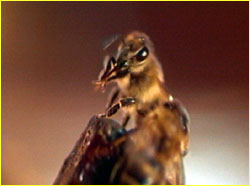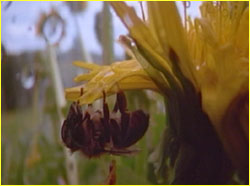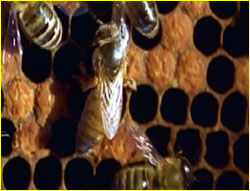
|

|

|
The Buzz About Bees
A Flush Fund of Fascinating Facts
by Maureen Dolan
|
 A worker bee eats a meal of honey, the colony's chief
source of nourishment.
A worker bee eats a meal of honey, the colony's chief
source of nourishment.
|
Home sweet home
-
Bees do not create honey; they are actually improving
upon a plant product, nectar. The honey we eat is nectar
that bees have repeatedly regurgitated and dehydrated.
-
The average American consumes a little over one pound of
honey a year.
-
In the course of her lifetime, a worker bee will produce
1/12th of a teaspoon of honey.
-
To make one pound of honey, workers in a hive fly 55,000
miles and tap two million flowers.
-
In a single collecting trip, a worker will visit between
50 and 100 flowers. She will return to the hive carrying
over half her weight in pollen and nectar.
-
A productive hive can make and store up to two pounds of
honey a day. Thirty-five pounds of honey provides enough
energy for a small colony to survive the winter.
-
Theoretically, the energy in one ounce of honey would
provide one bee with enough energy to fly around the
world.
-
Although Utah enjoys the title "The Beehive State," the
top honey-producing states include California, Florida,
and South Dakota. In 1998, the United States made over
89,000 metric tons of honey. China, the world's top
honey-producer, created more than 140,000 metric tons of
honey in 1997.
-
While foraging for nectar and pollen, bees inadvertently
transfer pollen from the male to the female components
of flowers. Each year, bees pollinate 95 crops worth an
estimated $10 billion in the U.S. alone. All told,
insect pollinators contribute to one-third of the
world's diet.
-
Most researchers believe the honeybee originated in
Africa. The first European colonists introduced
Apis mellifera, the common honeybee, to the
Americas. Native Americans referred to the bees as
"White Man's Fly." Today honeybees can be found all over
the world.
|
 Bees often shield themselves from rain, which can
chill their flight muscles to the point that they
cannot fly.
Bees often shield themselves from rain, which can
chill their flight muscles to the point that they
cannot fly.
|
Busybodies
-
Bees are not fast fliers; while their wings beat over
11,000 cycles per minute, their flight speed averages only
15 miles per hour. In comparison, a true fly in the genus
Forcipomyia beats its wings over 62,000 cycles per
minute. The Australian dragonfly
Austrophlebia costalis has been clocked flying at a
speed of 36 mph.
-
Bees possess five eyes. The three ocelli are simple eyes
that discern light intensity, while each of the two large
compound eyes contains about 6,900 facets and is well
suited for detecting movement. In fact, honeybees can
perceive movements that are separated by 1/300th of a
second. Humans can only sense movements separated by
1/50th of a second. Were a bee to enter a cinema, it would
be able to differentiate each individual movie frame being
projected.
-
While bees cannot recognize the color red, they do see
ultraviolet colors.
-
Unlike the stingers in wasps, the honeybee's stinger is
barbed. Once the stinger pierces a mammal's soft skin, the
attached venom pouch pumps a mixture containing melittin,
histamine, and other enzymes into the target. When the bee
pulls away, the barb anchors the stinger in the victim's
body. The bee leaves the stinger and venom pouch behind
and soon dies due to abdominal rupture. When a honeybee
stings another insect, such as a honey-plundering moth,
she does not leave her stinger planted in the invader. As
she retreats from the insect victim, her barbed stinger
tears through the insect's exoskeleton.
|
 Nurtured with food bearing a slightly higher sugar
content, queen bees are slightly larger than worker
bees.
Nurtured with food bearing a slightly higher sugar
content, queen bees are slightly larger than worker
bees.
|
Being the Queen
-
During the mating flight several drones will deposit
upwards of 90 million sperm in the queen's oviducts. The
queen, however, will not use all the sperm. She stores
about seven million sperm in a special pouch, the
spermatheca.
-
In one day a queen can lay her weight in eggs. She will
lay one egg per minute, day and night, for a total of
1,500 eggs over a 24-hour period and 200,000 eggs in a
year. Should she stop her frantic egg-laying pace, her
workers will move a recently laid egg into a queen cell to
produce her replacement.
-
While workers select which fertilized eggs to brood in
queen or worker cells, the queen decides the sex of her
young. In a mechanism of sex determination known as
haplodiploidy, fertilized eggs will become female
offspring, while unfertilized eggs will become males.
Maureen Dolan, NOVA Online's intern, worked with a bee
researcher from the University of Massachusetts Boston in
the summer of 1998.
Photos: ©1998 ORF.
The Making of |
Anatomy of a Hive
The Buzz About Bees |
Dances With Bees
Resources |
Transcript
| Site Map |
Tales from the Hive Home
Editor's Picks
|
Previous Sites
|
Join Us/E-mail
|
TV/Web Schedule
About NOVA |
Teachers |
Site Map |
Shop |
Jobs |
Search |
To print
PBS Online |
NOVA Online |
WGBH
©
| Updated October 2000
|
|
|


 A worker bee eats a meal of honey, the colony's chief
source of nourishment.
A worker bee eats a meal of honey, the colony's chief
source of nourishment.
 Bees often shield themselves from rain, which can
chill their flight muscles to the point that they
cannot fly.
Bees often shield themselves from rain, which can
chill their flight muscles to the point that they
cannot fly.
 Nurtured with food bearing a slightly higher sugar
content, queen bees are slightly larger than worker
bees.
Nurtured with food bearing a slightly higher sugar
content, queen bees are slightly larger than worker
bees.